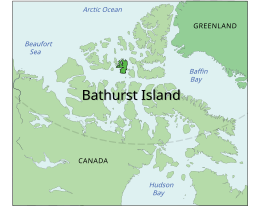Bathurst Island (Canada)

Satellite photo montage of Bathurst Island and its neighbours
|
|

Location of Bathurst Island
|
|
| Geography | |
|---|---|
| Location | Northern Canada |
| Coordinates | 75°46′N 099°47′W / 75.767°N 99.783°WCoordinates: 75°46′N 099°47′W / 75.767°N 99.783°W |
| Archipelago |
Queen Elizabeth Islands Canadian Arctic Archipelago |
| Area | 16,042 km2 (6,194 sq mi) |
| Area rank | 54th |
| Length | 117 mi (188 km) |
| Width | 63–94 mi (101–151 km) |
| Administration | |
| Territory | Nunavut |
| Demographics | |
| Population | 0 |
A member of the Canadian Arctic Archipelago, Bathurst Island is one of the Queen Elizabeth Islands in Nunavut, Canada. The area of the island is estimated at 16,042 km2 (6,194 sq mi), 115 to 117 miles (185 to 188 km) long and from 63 mi (101 km) to 72 mi (116 km) to 92.9 mi (149.5 km) wide, making it the 54th largest island in the world and Canada's 13th largest island. It is uninhabited.
The island is low-lying with few parts higher than 330 m (1,083 ft) in elevation. The highest point is 412 m (1,352 ft) at Stokes Mountain in the Stokes Range. This in turn forms part of the Arctic Cordillera mountain system. Good soil conditions produce abundant vegetation and support a more prolific wildlife population than other Arctic islands.
The island contains both the International Biological Program site Polar Bear Pass and Qausuittuq National Park.
Brooman Point Village on the eastern coast of Bathurst Island was the site of Thule native tribes around A.D. 1000, conceivably during a warmer climate episode. William Edward Parry was the first European to discover the island in 1819, charting its southern coast. It was named for Henry Bathurst, 3rd Earl Bathurst, British Secretary of State for War and the Colonies 1812-1827. Robert Aldrich charted much of its west coast in 1851, while George Henry Richards and Sherard Osborn charted its north coast in 1853.
...
Wikipedia
